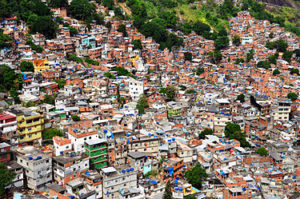Patricia Rodrigues Samora ~ Is This The End Of Slum Upgrading In Brazil?
 In Brazil’s ongoing economic and political drama, one of the latest developments is a congressional proposal to freeze federal funds at 2016 levels, adjusting the 2017 national budget only for inflation. This move would mean deep cuts to spending on social programnes.
In Brazil’s ongoing economic and political drama, one of the latest developments is a congressional proposal to freeze federal funds at 2016 levels, adjusting the 2017 national budget only for inflation. This move would mean deep cuts to spending on social programnes.
Though such reductions would affect programmes that launched millions of Brazilians into the middle class and put the developing country on track to meet many of the Millennium Development Goals, the senate seems likely to approve the budget freeze.
For Brazilian cities, this government belt-tightening promises a disquieting change: the possible end of the country’s ambitious slum-upgrading programs. Despite Brazil’s great wealth, many poor neighbourhoods known as favelas (slums or “informal settlements” in urban planning parlance) still struggle with inadequate construction quality, no sanitation, environmental risk factors and lack of the most basic infrastructure.
Read more: http://www.huffingtonpost.com/is-this-the-end-of-slum
Paola Totaro ~ Dying For A Pee: Cape Town’s Slum Residents Battle For Sanitation
 CAPE TOWN, Oct 12 (Thomson Reuters Foundation) – Siphesihle Mbango was just six years old when her friend, Asenathi, begged her to go with her to the toilet then ran outside alone – and was never seen again.
CAPE TOWN, Oct 12 (Thomson Reuters Foundation) – Siphesihle Mbango was just six years old when her friend, Asenathi, begged her to go with her to the toilet then ran outside alone – and was never seen again.
Now 12, Mbango tells the story with an intense, unflinching gaze but her hands, fidgeting nervously as she speaks, show the trauma is still raw.
“We were at the crèche and she wanted me to go with her,” but I told her I was busy, I was playing, I didn’t want to go and she went out by herself,” she said, at her home in a Cape Town slum.
“It was a long time she was away and when the teachers asked me, I told them she went to the toilet. They looked and looked for her for a long, long time. But then we lost hope. We never saw her again.”
Read more: http://www.thisisplace.org/
Welcome To Masdar City: The Ultimate Experiment In Sustainable Urban Living
Ten years ago in the United Arab Emirates, a new settlement was started from scratch, with the aim of becoming “the world’s most sustainable city”. Masdar City was designed to be zero-carbon and zero-waste, home to a population of 40,000 people, with an additional 50,000 commuters, in an area of six square kilometres. Today, it’s playing a crucial role in the development of sustainable design and technology.
Around the world, access to a reliable and plentiful energy supply is becoming increasingly critical. Urban populations continue to grow and demand even more energy. At the same time, vital resources such as water are becoming increasingly scarce, and rising levels of CO₂ and a warming global climate are adding to the stress on the Earth’s system.
All of this means that Masdar’s function as a test bed for innovations in fuel efficiency and renewable energy is more important than ever before. As part of a recent study, my colleagues and I took a closer look at the new technology on show in Masdar. Here’s what we found.
Read more: https://theconversation.com/welcome-to-masdar-city
Mark Binelli ~ Meet Architect Bjarke Ingels, The Man Building The Future
The convoy of buses departed from the Palazzo on a cloudless spring morning, rolling onto a muted Las Vegas Strip and toward the Nevada desert. The buses carried a group of tech journalists, venture capitalists, curious engineers and startup-culture hype merchants – along with, not incidentally, one of the world’s most celebrated architects, Bjarke Ingels – passing sere mountain ranges and spiky yucca trees and a shimmering field of solar panels before finally arriving, after nearly an hour, at their destination: a compound of trailers and shipping containers surrounded by a barbed-wire fence. Someone made a nuclear-test-site joke.
We’d come to witness the first-ever public demonstration of a new super-sonic transportation venture called Hyperloop One. Tech billionaire Elon Musk had roughed out the concept in 2013 and given his blessing to the founders, though he wasn’t directly involved himself. Essentially, the plan was for Hyperloop to revolutionize freight and passenger travel by shooting pods through pressurized tubes at speeds of more than 700 mph – faster than a commercial airplane! – using a zero-emission electric-propulsion system. This could mean half-hour trips from Los Angeles to the Bay Area.
Read more: http://www.rollingstone.com/meet-architect-bjarke-ingels
Adele Peters ~ Meet The Man Building A Plastic Bottle Village In Panama
When Robert Bezeau moved from Montreal to Panama in 2009, one of the first things he noticed was the trash: the beaches surrounding the island where he lived were lined with plastic bottles. In a year and a half, working with volunteers, he estimates that he collected more than a million bottles for recycling.
Surrounded by piles of bottles, Bezeau started wondering if they could be used for something new—a building material for houses in what he calls the Plastic Bottle Village. In a new short documentary from Mel Films, filmmaker David Freid visits Panama to see one of the houses now under construction.
Read more: https://www.fastcoexist.com/meet-the-man-building
David Satterthwaite & Cassidy Johnson ~ Ten Essentials For The New Urban Agenda In One Page
Ten concise points respond to the current draft of Habitat III’s New Urban Agenda which is lengthy, dense and gives too little attention to the key roles of local government and civil society.
Habitat III will seek global political commitment to making urban centres more sustainable, inclusive and resilient. But the latest draft of the New Urban Agenda – to be agreed at the summit – is long, impenetrable and gives little attention to urban governance. Frustrated by this unwieldy document, we have developed an alternative version of the New Urban Agenda – in one page.
Borrowing the format of the United Nations Office for Disaster Risk Reduction’s Ten Essentials for Making Cities Resilient (PDF) these short and practical points provide national governments with clear direction for a workable outcome from Habitat III.
The text does not include many important goals. It seeks instead to push attention away from long lists that repeat commitments already made to the means by which these can be met.
Ahead of the last negotiation meeting before the summit we share these guidelines and are keen to hear comments.
Read more: http://www.iied.org/ten-essentials-for-new-urban-agenda-one-page



